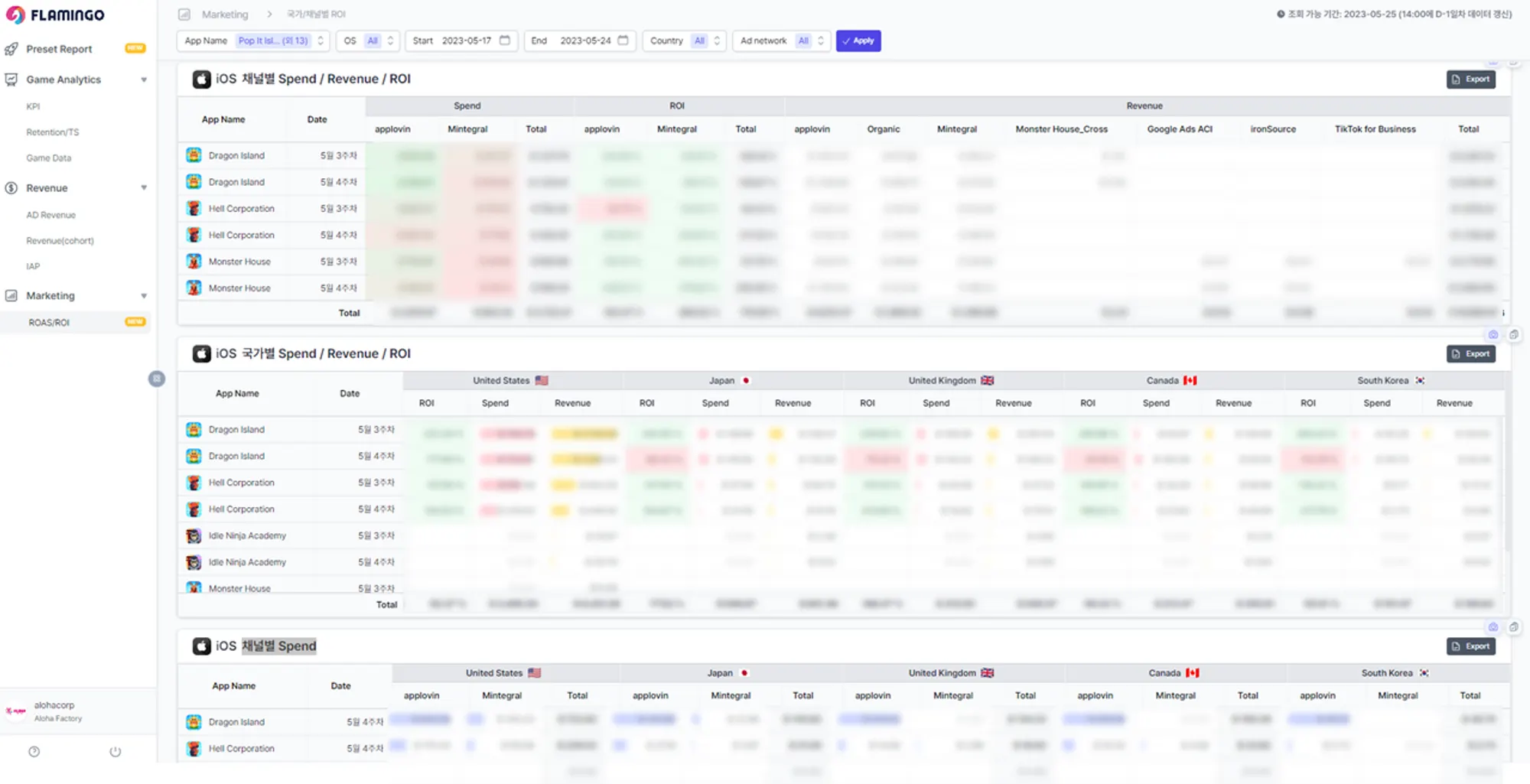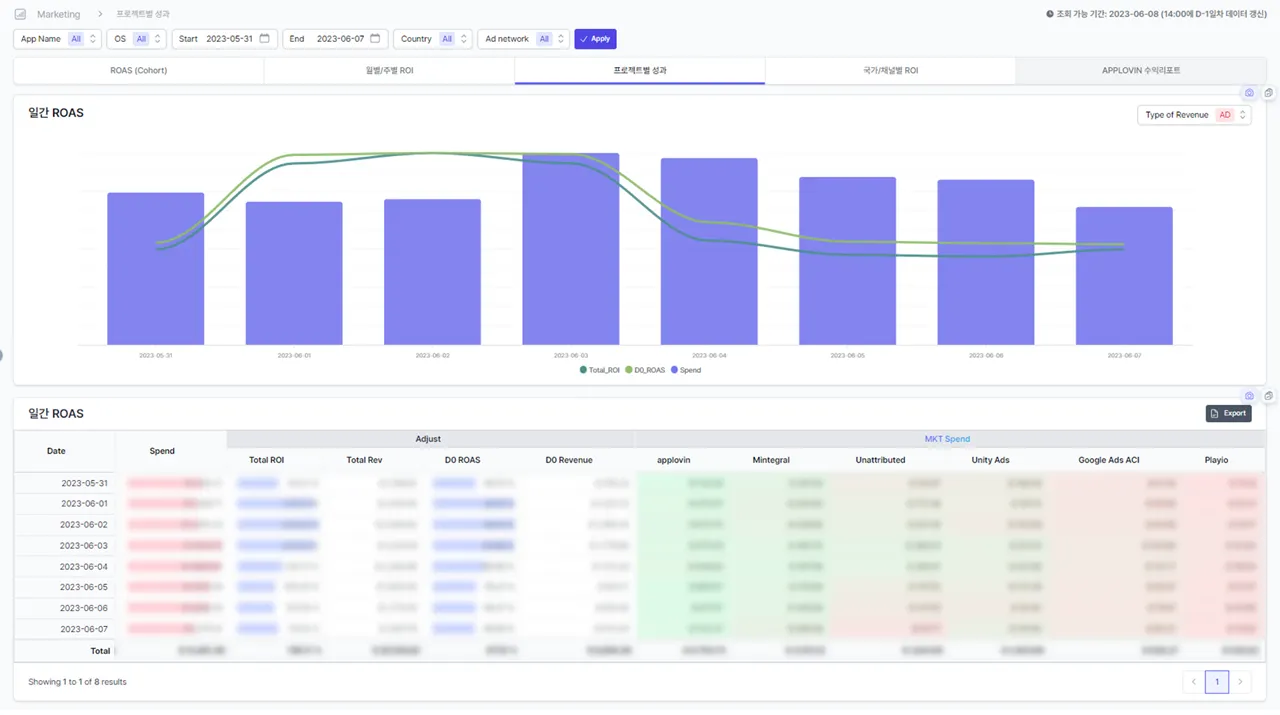What is ROAS?
Even if you generate substantial revenue from acquired users, if the cost of acquiring those users exceeds the revenue, the campaign cannot be deemed successful. Therefore, to maintain sustainable game services and generate profit, you must continuously monitor ROAS, the most critical metric in UA (User Acquisition).
ROAS (Return On Ad Spend) is a key performance indicator in marketing, representing the revenue generated compared to the cost of advertising. In other words, it shows how much revenue you have earned relative to the ad spend on a particular campaign. For example, if Aloha Factory spent $1,000 on a marketing campaign for Dragon Island and generated $2,000 in revenue, the game's ROAS would be 200%.
By measuring ROAS at specific intervals, such as N days after app installation, you can identify the channels and campaigns that bring in high-value users and adjust campaign creatives and channel management accordingly.
Calculating ROAS
ROAS is calculated simply as “revenue generated from an ad campaign / ad spend on the campaign.” However, the time frame for assessing “revenue generated” can significantly impact ROAS.
Typically, the period for calculating ROAS varies by game genre. This is because expected ARPU (Average Revenue Per User) and user retention differ by genre. For instance, hyper-casual games aim to achieve 100% ROAS within three days (Day 3), while genres like casino games with longer retention may extend the ROAS calculation period beyond a year. Recently, light-core games showing strong performance often reach 100% ROAS within seven days (Day 7).
As such, marketers must carefully decide the time frame for calculating revenue based on the game genre, profitability, and other key metrics to conduct efficient performance marketing.
What Defines a Good ROAS, and How Can You Achieve It?
It’s crucial to develop ad creatives that capture the core mechanics and fun of the game while grabbing users' attention. Continuously testing variations of these creatives and maintaining the most effective ones is essential.
At Aloha, we conduct weekly creative tests, constantly finding better-performing assets than previous winning ones.
Recently, Aloha Factory ran a campaign to improve the iOS ad ROAS for Monster House through Applovin. During the campaign, a tested creative achieved over 150% IPM (Installs per Mille), prompting a switch to the new creative, which resulted in impressive performance. The spend for this creative increased by 1200% compared to the two-week average during the same period.
An increase in overall spend indicates that the pool of users responding at the same ROAS percentage is growing. If this upward trend in spend continues, it could signal that the next stage of scaling up is worth considering.
The success of this creative was attributed to multiple rounds of testing, demonstrating its effectiveness for the target user base.
At Aloha Factory, we assign internal evaluation scores to marketing video concepts and develop variations through quantitative analysis, allowing us to refine and improve creative ideas.
Case Study: Creative Development Process
•
Several tests showed strong performance for videos emphasizing the monsters in Monster House.
•
Based on this, a new concept was developed that mixed a haunted house theme with an actual horror atmosphere for the Monster House game. The idea was to create a hook by showing a ghost being placed into objects and turning them into monsters.
•
Compared to simply placing monster-transforming furniture in set locations, allowing the player to freely place the ghost into objects gave a higher sense of control and was more intuitive for players to understand.
IPM: Installs per Mille (number of installs per 1,000 impressions, used to compare performance with previous videos)
•
Robin, Marketing Manager at Aloha Factory
•
Leonard, Creative Manager at Aloha Factory
At Aloha Factory, we generate weekly ROAS/ROI reports to monitor project performance. These reports help identify whether ad budgets are optimized and whether there are any issues, such as inaccurate target settings, across different projects, campaigns, and media sources. By analyzing these metrics, we can fine-tune campaigns to ensure the best performance, adjusting strategies where necessary to maximize efficiency. This level-based tracking is crucial for maintaining the effectiveness of UA marketing efforts.
1) Monitoring Project ROI Level → Campaign Level
When managing campaigns, it’s crucial to first monitor the overall ROI at the project level. This involves assessing the daily revenue that includes both user quality (retention/ARPU) and the contribution from organic users to determine weekly ROI and campaign performance.
In performance marketing, D0 ROAS is often used as an important metric because it provides the quickest insight into user quality. In genres where retention is longer, campaigns may not be adjusted immediately based solely on D0 ROAS. However, since D0 ROAS is effective in quickly monitoring user quality, Aloha Factory’s data analysis tool, FLAMINGO, has developed predictive models that estimate users' long-term LTV and ROAS based on early ROAS data.
At the campaign level, even if the D0 ROAS is low or appears favorable, if ROI is maintained at an appropriate level, no campaign adjustments are made.
(ROI reflects the total user revenue, including organic users, from the game.)
Why Should ROI Be Considered Alongside D0 ROAS, Even If D0 ROAS Looks Good?
D0 ROAS measures the profitability of user acquisition on the first day, but it doesn’t account for the game's long-term profitability or potential. If a game's concept goes viral, or if the retention rate or ARPDAU (Average Revenue Per Daily Active User) is strong, the game may perform well in the long run. Therefore, while D0 ROAS is helpful for monitoring the quality of users acquired through performance marketing, it's important to also track ROI daily to understand the broader picture.
D0 ROAS and ROI Analysis
① When D0 ROAS is low, but ROI is high:
This indicates that after Day 1, the user profitability, retention, or K-Factor (virality coefficient) is better than similar games. In this case, you can adjust marketing strategies based on user behavior after Day 1. If user profitability is high, focus ads on targeting high-spending users. If retention rates are high, optimize media targeting toward users similar to those who remain in the game. A high K-Factor, indicating strong organic user growth, suggests that brand marketing may also be effective.
② When D0 ROAS is high, but ROI is low:
In this opposite scenario, long-term user profitability is low, so it’s advisable to consider scaling up campaigns focused on short-term recovery. Even if you scale marketing gradually over time, accumulated DAU (Daily Active Users) might be insufficient. Therefore, it’s more effective to make quick decisions based on D0 metrics and boost campaigns in the short term to secure early organic users.
Robin, Marketing Manager at Aloha Factory
When ROI performance is poor, check the daily D0 ROAS for the campaign over a week and look at the weekly average. Even if there are daily fluctuations, ensure that the weekly average is stable. After confirming this, you can adjust the campaign as needed to improve performance.
How Are ROAS and ROI Typically Used in Campaigns?
ROAS: Used as a Cohort Revenue Metric
•
ROAS is used to group and track revenue over time from users who entered through specific campaigns on a particular day.
◦
Example: The D3 ROAS for a specific campaign tracks the cumulative revenue generated by paid users who entered through the campaign on June 1st, measured up until June 4th.
ROI: Used as a Daily Revenue Metric
•
ROI is calculated by checking the total revenue generated on a specific day, regardless of when or how the users entered.
◦
Example: To calculate the ROI for June 1st, divide the total revenue generated on that day by the costs incurred on June 1st, without considering which campaign brought in the users or when they joined.
2) From Campaign Level to App Source Level Analysis
There are instances when adjusting the bid price doesn't lead to significant improvements in campaign performance. In such cases, it's helpful to identify the root cause by reviewing the average performance of app sources over the past seven days. Start by checking the D0 ROAS of app sources with the highest spend to ensure you have a sufficient sample size.
During this analysis, you may find that the top 2-3 app sources, which account for a large portion of the spend, are underperforming. By resetting the bid price for just those specific app sources, you can improve the overall campaign performance.
Continuing this type of detailed analysis and adjustment at the app source level plays a critical role in maintaining optimal campaign settings and ensuring effective UA (User Acquisition) marketing operations.
What is an App Source?
When a campaign goes live, ad creatives are displayed on specific placements, which could be within certain games rather than platforms like YouTube. Each game where the ad is shown is referred to as an "app source."
For example:
•
If a Monster House video ad is shown in a game (let's call it "Game A") and performs well (e.g., an average D0 ROAS of 60% over a week).
•
Conversely, if the ad is displayed in a different game with a different user base, like a casino game, and performs poorly (e.g., an average D0 ROAS of 30%).
In such cases, you can either significantly lower the bid for that specific casino game or add the app source ID to a block list to prevent the ad from being displayed in that game.
This strategy is called app source bidding, where instead of adjusting the overall bid for the entire campaign, you adjust the bid for specific apps where your ads are being displayed.
Optimizing Budget with Performance Monitoring
Seasonal changes can lead to increased competition, resulting in a spike in ad spend but a drop in ARPU, negatively impacting overall performance. In such cases, immediately reducing the campaign budget is necessary to minimize the impact on project performance. Once performance stabilizes, the budget can be gradually increased to improve ROI.
At Aloha Factory, we maintain transparent communication with our publishing partners, offering global UA marketing services that help optimize game operations. We continually refine our processes and testing to bring in high-value users, helping game creators launch their games successfully in the global market. We hope these tips provide valuable insights to game developers.
Want to learn more about global marketing strategies for mobile games? Become a partner of Aloha Factory!
Tracking Performance by Level and Optimizing Campaigns
At Aloha Factory, we generate weekly ROAS/ROI reports to monitor project performance. These reports help identify whether ad budgets are optimized, target settings are accurate, and other potential issues. We start by reviewing project-level ROI, which includes both retention/ARPU and organic user contribution metrics, and then use this data to assess campaign performance.
In performance marketing, we often rely on D0 ROAS to manage campaigns, as it allows for quick monitoring of user quality. However, we don’t immediately adjust campaigns if the game genre has longer retention patterns. Aloha Factory's FLAMINGO solution uses early ROAS to predict long-term LTV and ROAS. We monitor both D0 ROAS and ROI daily to optimize performance.
Analyzing D0 ROAS and ROI
① If D0 ROAS is low but ROI is high:
This means that the long-term user profitability, retention, or viral coefficient (K-Factor) is better than similar games. Depending on the users' behavior after Day 1, marketing strategies can be adjusted, such as targeting high-spending users with specific ads or refining media strategy based on retention metrics.
② If D0 ROAS is high but ROI is low:
In this case, the long-term user profitability is lower, so it may be beneficial to focus on short-term, rapid scale-ups using channels that allow for quick recovery. A boost in organic numbers at the early stage could help balance this.

_(12).png&blockId=384a9ae9-bfbb-4b27-9810-57acd8c765b2&width=3600)
_(12).png&blockId=5a468930-f20f-44a9-b670-4a03c8251548)

